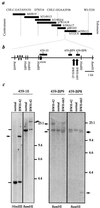Frequent fusion of the JAZF1 and JJAZ1 genes in endometrial stromal tumors
- PMID: 11371647
- PMCID: PMC33471
- DOI: 10.1073/pnas.101132598
Frequent fusion of the JAZF1 and JJAZ1 genes in endometrial stromal tumors
Abstract
Endometrial stromal tumors are divided into three types: benign stromal nodules, endometrial stromal sarcomas, and undifferentiated endometrial sarcomas. A variety of cytogenetic abnormalities involving chromosome 7 have been reported in endometrial stromal sarcomas, including a recurrent t(7;17)(p15;q21). We have identified two zinc finger genes, which we have termed JAZF1 and JJAZ1, at the sites of the 7p15 and 17q21 breakpoints. Analyses of tumor RNA indicate that a JAZF1/JJAZ1 fusion is present in all types of endometrial stromal tumors; however, the fusion appears to be rarer among endometrial stromal sarcomas that would be considered high-grade according to certain classification schemes. These findings suggest that the less malignant endometrial stromal tumors may evolve toward more malignant types, but that some endometrial stromal sarcomas with relatively abundant mitotic activity may compose a biologically distinct group.
Figures




References
-
- Zaloudek C, Norris H J. In: Blaustein's Pathology of the Female Genital Tract. Kurman R J, editor. New York: Springer; 1994. pp. 487–528.
-
- Norris H J, Taylor H B. Cancer. 1966;19:755–766. - PubMed
-
- Tavassoli F A, Norris H J. Histopathology. 1981;5:1–10. - PubMed
-
- Evans H L. Cancer. 1982;50:2170–2182. - PubMed
-
- Chang K L, Crabtree G S, Lim-Tan S K, Kempson R L, Hendrickson M R. Am J Surg Pathol. 1990;14:415–438. - PubMed
Publication types
MeSH terms
Substances
Grants and funding
LinkOut - more resources
Full Text Sources
Other Literature Sources
Molecular Biology Databases

